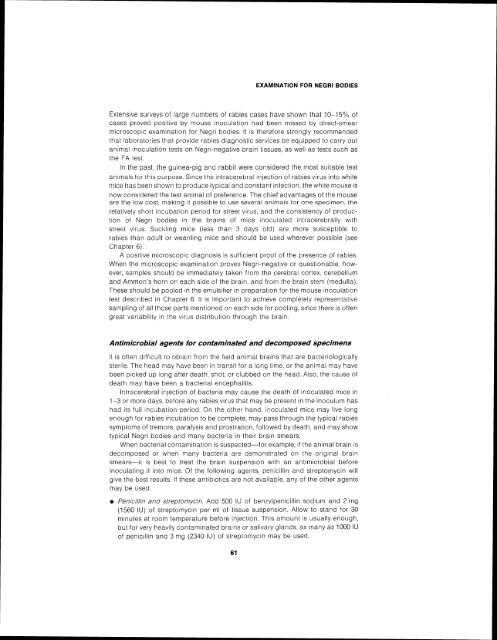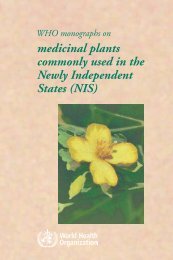in rabies - libdoc.who.int - World Health Organization
in rabies - libdoc.who.int - World Health Organization
in rabies - libdoc.who.int - World Health Organization
You also want an ePaper? Increase the reach of your titles
YUMPU automatically turns print PDFs into web optimized ePapers that Google loves.
EXAMINATION FOR NEGRI BODIES<br />
Extensive surveys of large numbers of <strong>rabies</strong> cases have shown that 10-15% of<br />
cases proved positive by n-iouse <strong>in</strong>oculation had been missed by direct-smear<br />
microscopic exam<strong>in</strong>ation for Negri bodies It is therefore strongly recommended<br />
that laboratories that provide <strong>rabies</strong> diagnostic services be equipped to carry out<br />
animal <strong>in</strong>oculation tests on Negri-negative bra~n t~ssues as well as tests such as<br />
the FA test<br />
In the past the gu<strong>in</strong>ea-pig aiid rabbit were considered the most suitable test<br />
animals for this purpose Sirice the <strong>in</strong>tracerebral <strong>in</strong>jection of <strong>rabies</strong>vrus <strong>in</strong>to white<br />
mlce lias been shown to produce typical and constant ~nfection, the white mouse is<br />
now considered the test animal of preference The chief advantages of the mouse<br />
are the low cost mak<strong>in</strong>g it possible to use several animals for one specimen the<br />
relatively short <strong>in</strong>ciibation period for street virus and the consistency of production<br />
of Negri bodies <strong>in</strong> the bra ns of mice ~noculated ntracerebraily with<br />
street virus Suckl<strong>in</strong>g <strong>in</strong>ice (less than 3 days old) are more susceptible to<br />
<strong>rabies</strong> than adult or weanlng mice and should be used wherever possible (see<br />
Chapter 6)<br />
A positive microscopic diagnosis is sufficient proof of the presence of <strong>rabies</strong><br />
When the microscopic exam<strong>in</strong>ation proves Negri negative or questionable however<br />
samples should be immediately taken fro<strong>in</strong> the cerebral cortex cerebellum<br />
and Ammon s horn on each side of the bra<strong>in</strong> and from the bra<strong>in</strong> stem (medulla)<br />
These should be pooled <strong>in</strong> the emulsifier <strong>in</strong> preparation for the mouse <strong>in</strong>oculation<br />
test described <strong>in</strong> Chapter 6 It is important to achieve completely representative<br />
sampl<strong>in</strong>g of all those parts mentioned on each side for pool<strong>in</strong>g s<strong>in</strong>ce there is often<br />
great variability <strong>in</strong> the virus distribution through the bra<strong>in</strong><br />
Antimicrobial agents for contam<strong>in</strong>ated and decomposed specimens<br />
It is often difficult to obta~n from the field animal bra<strong>in</strong>s that are bacteriologically<br />
sterile. The head may have been <strong>in</strong> transit for a long time or the animal may have<br />
been picked up long after death. shot. or clubbed on the head. Also, the cause of<br />
death may have been a bacterial encephalitis.<br />
lntracerebral <strong>in</strong>jection of bacteria may cause the death of rnoculated mice <strong>in</strong><br />
1-3 or more days. before any <strong>rabies</strong> virus that may be present <strong>in</strong> the <strong>in</strong>oculum has<br />
had its full <strong>in</strong>cubation period. On the other hand, <strong>in</strong>oculated mice may live long<br />
enough for <strong>rabies</strong> <strong>in</strong>cubation to be complete, may pass through the typical <strong>rabies</strong><br />
symptoms of tremors, paralysis and prostration, followed by death, and may show<br />
typical Negri bodies and many bacteria <strong>in</strong> their bra<strong>in</strong> smears.<br />
When bacterial contamiriation is suspected-for example, if the animal bra<strong>in</strong> is<br />
decomposed or when many bacteria are demonstrated on the orig<strong>in</strong>al bra<strong>in</strong><br />
smears-it is best to treat the bra<strong>in</strong> suspension with an antimicrobial before<br />
<strong>in</strong>oculat<strong>in</strong>g it <strong>in</strong>to mice. Of the follow<strong>in</strong>g agents, penicill<strong>in</strong> and streptomyc<strong>in</strong> will<br />
give the best results, If these antibiotics are not available, any of the other agents<br />
may be used.<br />
Pen~cill<strong>in</strong> and streptomyc<strong>in</strong>. Add 500 IU of benzylpenicill<strong>in</strong> sodium and 2 mg<br />
(1560 IU) of streptomyc<strong>in</strong> per ml of tissue suspension. Allow to stand for 30<br />
m<strong>in</strong>utes at room temperati~re before ~njection. This amount is usually enough,<br />
but for very heavily contam<strong>in</strong>ated bra<strong>in</strong>s or salivary glands, as many as 1000 IU<br />
of penicill<strong>in</strong> aiid 3 mg (2340 IU) of streptomyc<strong>in</strong> may be used.
















